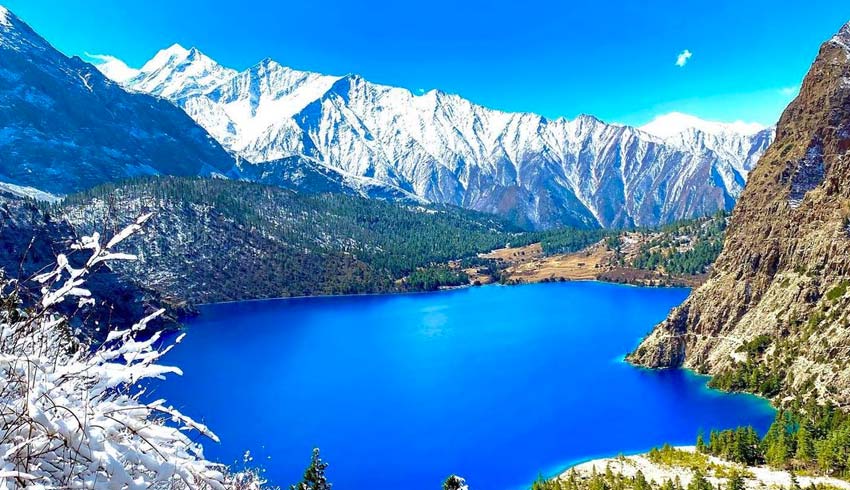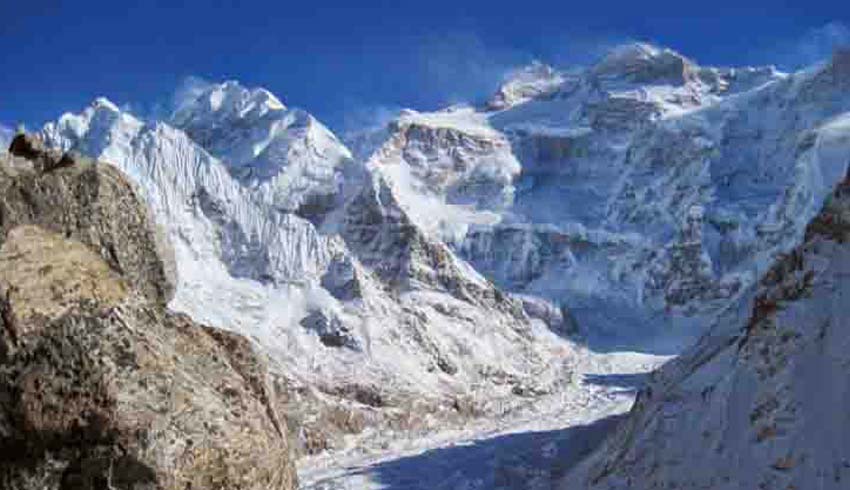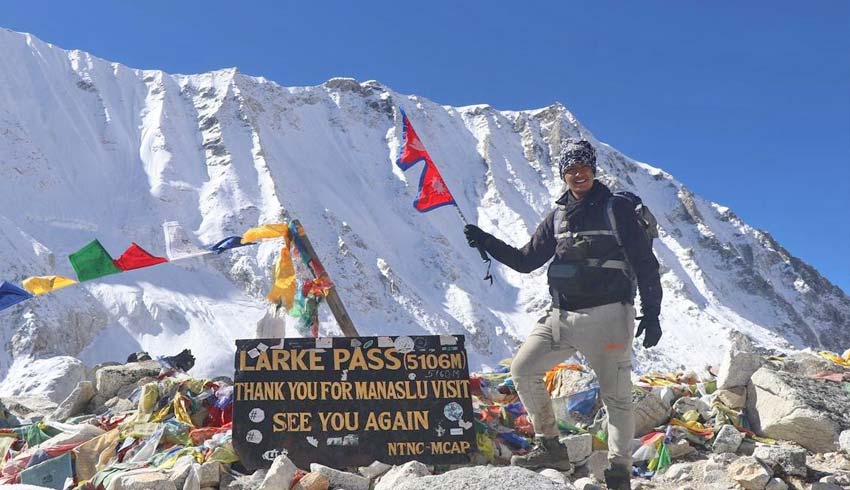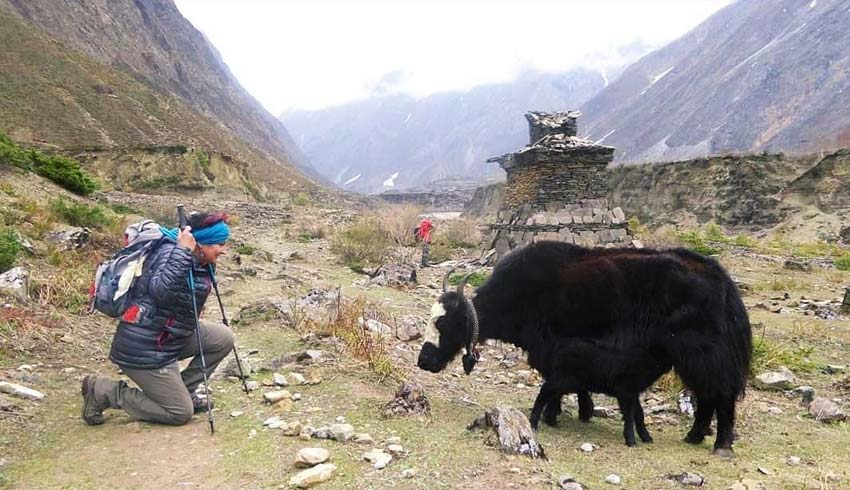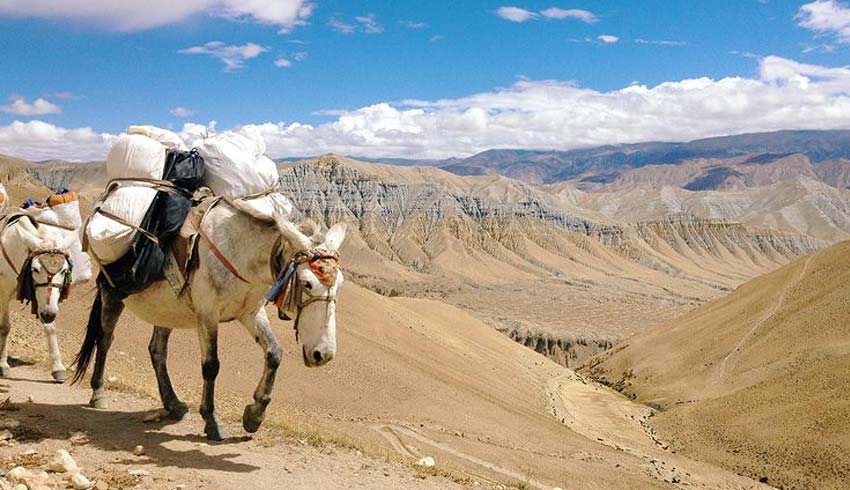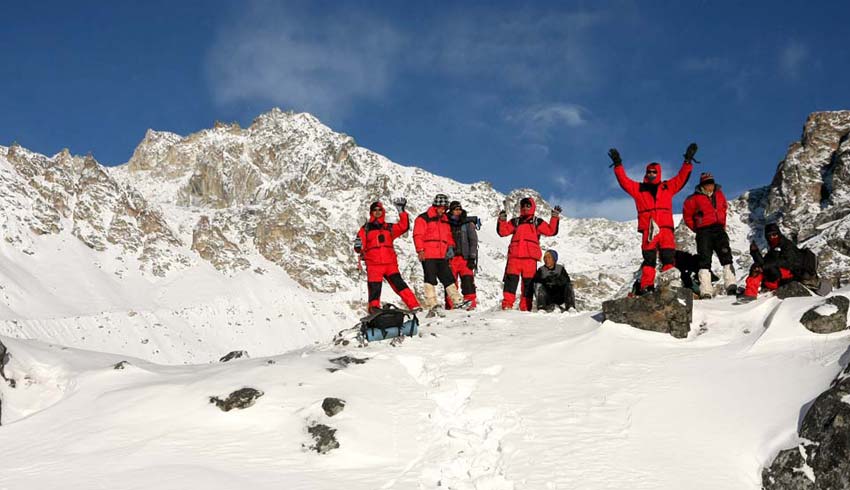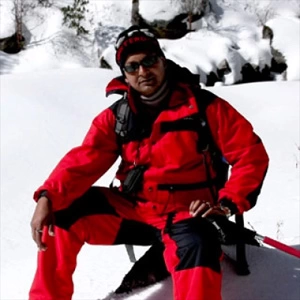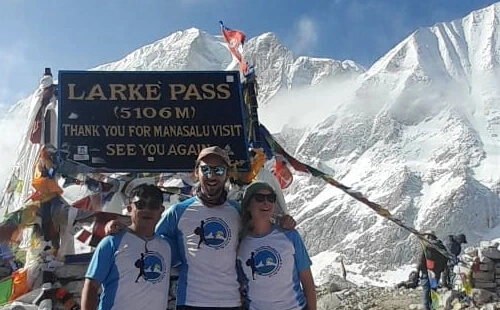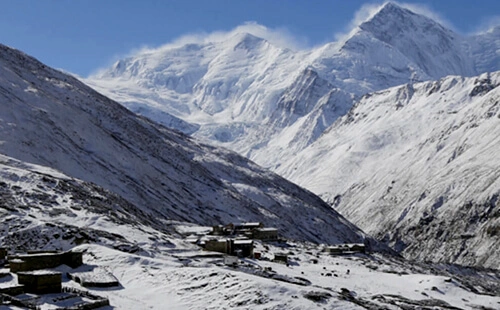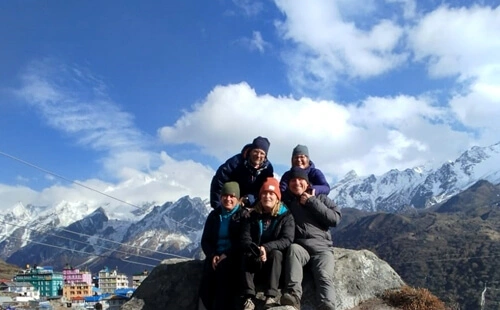Off the beaten treks in Nepal are pristine, intact and unexplored trekking destinations that take you away from the city life. These remote destinations are best to explore by following the trekking trails and travelling with a local guide. Being surrounded by natural beauty and varied landscapes, they are less crowded trekking routes of Nepal and are less visited. However, they are still the #1 choice of adventurous trekkers around the world.
The best thing about all these less popular treks is they let you discover the isolated countryside of Nepal. You will be amazed to see how people in remote areas are still unaffected by modernization and are happy with their own culture and civilization. Hikes and trekkers will be able to explore rare trails that provide you glimpse of Himalayas of Nepal and homely environment.
Here we have tried our best to enlist the top 10 best off-the-beaten-treks in Nepal.
1.Upper Dolpo Trek
Situated between the Dhaulagiri range and Tibetan plateau, the trek to Upper Dolpo was opened to tourism only in 1989. This restricted trekking trail is surrounded by Shey Phoksundo National Park which let you explore the varied flora and fauna and endangered wildlife such as Snow Leopard, Himalayan Blue Sheep, Goral, Thar etc. Also, it borders Tibet and is highly influenced by the Tibetan culture and traditions. It is best to travel with your group.
Trekking to Upper Dolpo independently is impossible as it is still considered as the restricted area by the Government of Nepal and the trails are difficult to achieve alone. So, to obtain the permits, a registered trekking agency and local guide of Nepal is mandatory.
Located in the Western Nepal, this area is remote, underdeveloped and is regarded as off-the-beaten path. However, Shey Phoksundo Lake (3,600m), Buddhist Monasteries like Shey Gompa, challenging high passes like Kang - La Pass, view of Dhaulagiri range, unique Tibetan culture, Bon Po Buddhist culture etc. will make your trip worthy and wonderful.
Photo Credit:@morri93
Upper Dolpo Trek Highlights
- Passing through the ancient trans-Himalayan trading trails
- Experiencing the camping trek under the shadow of Dhaulagiri ranges and other snow-white peaks
- Trekking through the largest National Park of Nepal - Shey Phoksundo National Park and encountering with the varied species of plants and animals
- Getting to know about the culture and lifestyle of the Bon Buddhist followers
- Exploring the stunning Shey Phoksundo Lake of turquoise shape
- Interacting with the locals influenced by Tibetan lifestyle and visiting the ancient monasteries such as Shey Gompa
Getting There
Being a remote area, reaching the Upper Dolpo is difficult. First, you have to reach Nepalgunj and then, to Juphal from where your trekking begins. Nepalgunj is accessible by both flight and road drive. However, most travellers prefer directly flying to Nepalgunj from either Kathmandu or Pokhara because of dangerous overland trips.
From Nepalgunj, you then fly to Juphal. While flying to Juphal, be ready to face the delayed flights because of unpredictable weather changes as the airport at Juphal is a tiny mountain airstrip.
If you want to trek the Upper Dolpo through the road, then first you should catch the night bus from Kathmandu to Nepalgunj which takes around 14 - 15 hours. From Nepalgunj, you can take another bus to Jajarkot. And from this point, you should travel on rough, twisted, and unpaved roads either by jeep or tractor to Radi. From Radi, you need to trek for 3-4 days to reach Dolpo.
Upper Dolpo Trek at Glance
| Destination: | Nepal |
| Starting Point: | Kathmandu |
| Ending Point: | Kathmandu |
| Days: | 15 to 25 Days |
| Max. Altitude: | 5,360m |
| Best Season: | Spring (March, April and, May), Monsoon (June, July, and August), and Autumn (September, October, and November) |
| Permit: | Upper Dolpo Restricted Area Permit, Lower Dolpo Restricted Area Permit and Shey Phoksundo National Park Entry Permit |
| Accommodation: | Camping/Teahouse |
2.Kanchenjunga Base Camp Trek
Kanchenjunga Base Camp Trek is off-the-beaten-path-trek in Nepal which is located in the eastern part of Nepal. It takes you to the foot of the world's third highest peak, Kanchenjunga (8,586m). This region is inhabited by Sherpa, Rai, Limbu, and Gurung which gives you an opportunity to learn about their solidarity and culture. Kanchenjunga Conservation Area is the major attraction of this trek which is home to flora and fauna and wildlife such as Red Panda, Snow Leopard, Wild Boar etc.
The trekking trail of this region is challenging because of which the Government of Nepal has restricted this region and has made it mandatory to trek Kanchenjunga Base Camp with a guide and need at least two members in the group.
It is the restricted trekking area of Nepal to protect the originality of the culture and to control the flow of tourists in this region. During this trip, you will be able to explore the rare views of peaks such as Kanchenjunga, Lhotse, Makalu, Everest etc. Similarly, the trekking trail follows the changing landscapes, rocky slopes, glacial moraine, small rivers etc. This route can be trekked with your friends group.
Kanchenjunga Base Camp Trek Highlights
- Splendid views of the huge peaks such as Lhotse (8516m), Everest (8848m), Kanchenjunga (8586m), Makalu (8481m) etc.
- Exploring Kanchenjunga Conservation Area
- Interacting with the mixed communities and learning about their way of life
- Passing through the adventurous route along with the group and guide
- Crossing the challenging Mirgin La Pass (4,500m)
- Trekking through the route following the Tamur and Ghunsa rivers
- Passing through the Arun Valley
Getting There
Taplejung is the entrance point of the Kanchenjunga Base Camp Trek. You can reach there by either flight or road drive. Most preferred way is to fly directly to Suketar from Kathmandu. However, being a remote region and a small airport, there is no availability of daily flights and there may be delay in flight because of changes in weather.
Another alternative way is to first fly from Kathmandu to Bhadrapur as this flight is operated daily. From Bhadrapur, drive straight towards Taplejung by local bus or by jeep. However, we recommend you to drive through jeep which takes around 8 hours as the local bus takes more time and is terribly slow.
You can also reach Taplejung all the way from road drive. First, you can drive from Kathmandu to Birtamod which takes around 12 hours. The road is very flat and good in condition. From Birtamod, take another 10 hours' drive to Taplejung. Overall, the road is in suitable condition and you can have an enjoyable overland trip but makes your trip little longer. It is best if you travel through the private jeep/car, if you are planning for an overland trip.
Kanchenjunga Base Camp at Glance
| Destination: | Nepal |
| Starting Point: | Kathmandu |
| Ending Point: | Kathmandu |
| Days: | 20 to 28 Days |
| Max. Altitude: | 5,360m |
| Best Season: | Spring (March, April and, May) and Autumn (September, October, and November) |
| Permit: | Kanchenjunga Restricted Area Permit and Kanchenjunga Conservation Area Project Entry Permit |
| Accommodation: | Camping/Teahouse |
3.Manaslu Circuit Trek
Surrounded by Annapurna in the west and Ganesh Himal in the east, this trek was opened to foreigners only in 1991. This trek takes you around the 8th highest peak in the world, Manaslu (8,163m). Also, this trekking passes along the Budhi Gandaki River which used to be the ancient salt trading route of Nepal.
Solo Manaslu Circuit Trek is forbidden as this area is protected by the Government of Nepal. So, you need to obtain permits, there should be a minimum 2 people in a group and travel through a registered trekking agency and local guide of Nepal, to legally enter into this area.
Being a less crowded trekking trail, you can see 10 times less trekkers in this route as compared to other popular trekking destinations of Nepal. Throughout the journey, you will be able to explore the subtropical forests, challenging high passes, perfect bonding between Hinduism and Buddhism, river gorge and many suspension bridges.
Photo Credit:@rajanghimiree
Manaslu Trek Highlights
- Crossing the high and challenging pass - Larky La Pass ( 5,167m)
- Trekking through the lush forests covered by Rhododendron
- Opportunity to explore the Manaslu Conservation Area where you can encounter wildlife like Pika, Himalayan Tahr etc.
- Magnificent views of the giant peaks such as Manaslu, Kang Guru, Annapurna II etc.
- Interacting with the Sherpa locals and learning about their authentic cultures and traditions
Getting there
Manaslu Circuit Trek begins from Soti Khola. This trek is easily accessible from Kathmandu as it is just 126km drive from this city. It will take around 6 hours by Jeep and 8-9 hours by local bus to reach there. You can find local buses departing to Soti Khola in Gongabu Bus Park between 6am to 8am.
You will reach Soti Khola via Arughat. The road condition up to Arughat is good; however, after that you need to drive through bumpy and dusty roads. So, during Monsoon, if the road is too challenging, be ready to start your trek from Arughat.
Manaslu Trek at Glance
| Destination: | Nepal |
| Starting Point: | Kathmandu |
| Ending Point: | Kathmandu |
| Days: | 13 to 17 Days |
| Max. Altitude: | 5,213m |
| Best Season: | Spring (March, April and, May) and Autumn (September, October, and November) |
| Permit: | Manaslu Restricted Area Permit, Manaslu Conservation Area Project Permit, and Annapurna Conservation Area Project Permit |
| Accommodation: | Teahouse |
4.Makalu Base Camp Trek
Makalu Base Camp Trek is a less crowded trekking route of Nepal which takes you to the foot of the world's 5th highest mountain i.e., Makalu (8,481m). This trek takes you to the higher altitude where you will pass through the dense lush forests filled with Rhododendron, Sherpa and Rai settlement, small river valleys and the Makalu Barun National Park. From the top of base camp, you can observe the complete views of Mt. Everest, Lhotse, Barun Glacier, south face of Makalu etc.
Being a restricted and remote area, it is mandatory for you to travel with a guide and group consisting of at least 2 people.
Crossing Tutu La Pass is one of the adventurous things you will perform here. Also, Makalu Barun National Park, which is home to 3000 species of plants, 440 species of birds and 75 species of Mammals etc., is the major attraction of this trek. This trek is also considered as the good photography territory as it has green pastures, open fields, snow-capped peaks, glaciers etc. This trekking trail is filled with flapping prayer flags, Chortens, Mani walls etc.
Makalu Base Camp Trek Highlights
- Exploring Makalu Barun National Park which has varied flora and fauna, wildlife such as Snow Leopard, Himalayan Thar etc.
- Passing through the thundering waterfalls, high-altitude lakes, river gorges, Sherpa and Rai communities etc.
- Panorama of the highest peaks of the world such as Mt. Everest, Makalu, Lhotse etc.
- Great trekking route for the photographer where some good captures of natural beauty, distinct culture and beautiful landscapes etc. can be made
- Interaction with the Rai communities at lower elevation and Tibetan Sherpa communities at the higher elevation
Getting there
Num Bazaar is the starting point of this trek. The most preferred way to reach there is first, taking a 40 minutes long flight from Kathmandu to the small airport located in the Tumlingtar. Being a small airport, be ready to face the flight delay. After reaching there, you can reserve a private car/jeep, and head towards Maane Bhanjyang via Khaadbari. You can also get access to public Jeep; however, it doesn't move without getting all the seats packed. So, better to reserve the private one.
From Maane Bhanjyang ticket station, you can book the ticket for the further drive to Num Bazaar. You will reach Num Bazaar after around 3 hours' drive.
You can also start your trip by road drive from Kathmandu. You will follow the route of Kathmandu-Itahari-Dhankuta-Hile-Leguwa-Sabha Khola-Sayou Thau. The condition of the road till Sayou Thau is flat and pitched. Then, you will drive to Chichila for around 3 hours. The road condition is unpaved, rough and dangerous for the starting 1 hour but later it gets smooth. Then, from Chichila you can drive directly to the Num bazaar which takes around 2 hours.
Makalu Base Camp Trek at Glance
| Destination: | Nepal |
| Starting Point: | Kathmandu |
| Ending Point: | Kathmandu |
| Days: | 20 to 25 Days |
| Max. Altitude: | 5,120m |
| Best Season: | Spring (March, April and, May) and Autumn (September, October, and November) |
| Permit: | Makalu Barun National Park and Conservation Area Permit and Makalu Rural Municipality Permit |
| Accommodation: | Teahouse |
5.Tsum Valley Trek
Tsum valley trek, located in northern Gorkha, is one of the isolated and hidden trekking destinations in Nepal. This trek is famous as a pilgrimage valley and is inhabited by the origin of the Tibetan people. The locals of this valley have their own culture, traditions, and language. Also, it offers remarkable unspoiled natural beauty to the trekkers along with the glimpse of peaks such asGanesh Himal, Shringi Himal, Boudha Himal etc. This trek makes the perfect destination for the family vacation.
Being a restricted region, Tsum Valley Trek should be traveled with a guide and at least 2 people in group as pet the regulations of the Government of Nepal.
Because of its restriction for foreigners until 2008, this trekking destination hasn't gained much exposure yet. This trek offers you the deep insight of Tibetan Buddhist culture. It is extraordinarily rich in ancient monasteries such as Mu Gompa, Rachen Gompa etc. Also, you will feel the aura of Buddhist culture as soon as you enter the trekking trail because the route you will be following is filled with flapping prayer flags, Mani walls, thangka paintings etc. Also, this trek offers you the views of rivers, forests, caves etc.
Photo Credit:Françoise Fay-Chatelard
Tsum Valley Trek Highlights
- Learning about authentic Tibetan Buddhist culture
- Interacting with the locals and getting a chance to know about their lifestyle, culture, and traditions
- Passing through the dense lush forests which is home to the varied biodiversity
- Exploring rivers, waterfalls, and ancient caves
- Visiting Monasteries like Mu Gompa, Rachen Gompa
- Spiritual journey that offers you the trail filled with prayer flags and wheels, Mani walls carved with Buddhist mantras etc.
- Splendid views of the Himalayas such as Himal Chuli, Ganesh Himal etc.
Getting There
Tsum Valley Trek follows the same starting route as Manaslu Circuit Trek. It begins from Soti Khola. This trek is easily accessible from Kathmandu as it is just 126km drive from this city. It will take around 6 hours by Jeep and 8-9 hours by local bus to reach there. You can find local buses departing to Soti Khola in Gongabu Bus Park between 6am to 8am.
You will reach Soti Khola via Arughat. The road condition up to Arughat is good; however, after that you need to drive through bumpy and dusty roads. So, during Monsoon, if the road is too challenging, be ready to start your trek from Arughat.
Tsum Valley Trek at Glance
| Destination: | Nepal |
| Starting Point: | Kathmandu |
| Ending Point: | Kathmandu |
| Days: | 15 to 20 Days |
| Max. Altitude: | 3,700m |
| Best Season: | Spring (March, April and, May) and Autumn (September, October, and November) |
| Permit: | Tsum Valley Restricted Area Trek, Manaslu Restricted Area Permit, Manaslu Conservation Area Project Permit, and Annapurna Conservation Area Project Permit |
| Accommodation: | Teahouse |
6.Upper Mustang Trek
Located in the Northern part of Nepal, this region has been opened to foreigners only since 1992. It borders Tibet as a result its cultural and geographical structures are similar to this nation. Trek to Upper Mustang takes you to the pristine region of Nepal which used to be Buddhist Kingdom of Nepal during past days. Previously, it was also known as Kingdom of Lo. It is a suitable trekking trail to visit with your family and group.
To trek to Upper Mustang, there should be at least 2 people in a group and the involvement of the registered trekking agency and local guide of Nepal.
Throughout the journey, you will be able to explore the different hidden treasures of the Lo Kingdom from ancient caves and monasteries to archaeological sites. Authentic Buddhist culture with the touch of Tibetan culture can be observe in this region. This trek is famous for Namgyal Gompa, Traditional Tibetan Hospital, King and Queen Palace at Lo Manthang, Ghar Gompa, Tingkhar etc.
Upper Mustang Highlights
- Panorama of the giant peaks of Nepal such as Annapurna, Dhaulagiri, Nilgiri etc.
- Exploring the true Buddhist region filled with waving prayer flags, Mani walls carved with Buddhist mantras, ancient Monasteries etc.
- Chance to celebrate Upper Mustang Tiji festival with vibrant energy
- Passing through less crowded trekking trail of Nepal while exploring the unspoiled old Buddhist Kingdom
- Visiting Korala Border which used to be popular salt trading route between Tibet and Nepal
- Getting to know about Tibetan culture as Upper Mustang is highly influenced by this nation in terms of everything
Getting There
Jomsom is the starting point of this trek. The most preferred way to reach Jomsom is by flight. There is no direct flight from Kathmandu to Jomsom. So, first you will take a 30 minutes short flight from Kathmandu to Pokhara. Then, another 20 minutes flight from Pokhara to Jomsom.
Jomsom is also accessible by road. It will take around 12 hours to reach Jomsom from Kathmandu by private jeep/car. From the local bus, first you need to drive to Pokhara which will take around 9 hours. Then, from the bus park of Pokhara, you need to take another bus to Beni. From Beni, you will continue to drive towards Ghasa. Finally, you will take the last one bus from Ghasa and reach Jomsom.
We suggest you travel through flight or jeep as it is more convenient and easy. Also, the road condition from Beni is rough and Bumpy.
Upper Mustang Trek at Glance
| Destination: | Nepal |
| Starting Point: | Kathmandu |
| Ending Point: | Kathmandu |
| Days: | 14 to 18 Days |
| Max. Altitude: | 3,880m |
| Best Season: | Spring (March, April and, May), Monsoon (June, July, and August) and Autumn (September, October, and November) |
| Permit: | Upper Mustang Restricted Area Permit and Annapurna Conservation Area Project Permit |
| Accommodation: | Teahouse |
7.Lumba Sumba Pass Trek
Surrounded by third highest peak in the world to the west i.e., Kanchenjunga (8,586m) and fifth highest mountain in the world to the east i.e., Makalu (8481m), Lumba Sumba Pass trek provides you the lifetime opportunity to explore the less crowded trekking trail in Nepal. This trek was opened to tourists only from 2012 so this majestic remote region is still unknown to a lot of travellers. One of the major reasons behind trekking this region is to get the bird-eye view of the two giant peaks - Kanchenjunga and Makalu.
This trek begins from Kanchenjunga Conservation Area and ends at Tumlingtar, both of which are regarded as a restricted region. So, it is mandatory for you to travel with a local guide and registered trekking agency in a group having at least 2 people.
Throughout the way, you will be rewarded with some of the best views such as Himalayan landscapes, monasteries, school, varied wildlife, plant spices, birds, villages etc. You will pass through both Kanchenjunga Conservation Area and Makalu Barun National Park which provide you the glimpse of endangered animals such as Leopard, Red Panda etc. You will also get a chance to interact with the ethnic villagers who are mainly Sherpa, Gurung, Limbu, Rai etc. You even have to go through some wilderness trails and have to cross the challenging passes, so it also makes your journey fully adventurous.
Lumba Sumba Pass Trek Highlights
- Splendid view of the two giant peaks such as Kanchenjunga and Makalu
- Encounters with endangered wildlife such as leopards, red pandas etc.
- Trekking through the deeps lush forests covered with blooming Rhododendron
- Interacting with the ethnic villages and learning about their lifestyle, culture and traditions
- Enjoy the bird watching in the stunning Arun Valley
- Discover the mixed culture of the villages and pay visit to numerous chortens, temples, monasteries, prayer flags etc.
Getting There
Taplejung is the starting point of Lumba Sumba Pass trek. You can reach there either by flight or by road transportation. If you are looking to fly directly from Kathmandu to Taplejung, then you have the option to take flight to Suketar airport, located in Taplejung. However, because of remoteness, climatic conditions, and being a small airport, Tribhuvan International Airport doesn't run the daily flight to Suketar and also there is a huge chance of being delayed in flights.
Beside this, you also have another alternative way to use flight service to trek this region. First, you need to fly from Kathmandu to Bhadrapur. Don't worry as this flight service is operated daily. From Bhadrapur, you can directly drive towards Taplejung which takes around 8 hours by jeep. You have the option of both public and private vehicles; however, we recommend you to drive by private vehicles such as Jeep, car etc. Comparatively, local buses take more time and don't provide a comfortable journey as compared to private vehicles.
Finally, you can also reach Taplejung by road transpiration. First, you need to drive from Kathmandu to Ilam which takes around 11-12 hours. The road is in better condition and is very flat. Then, you can drive straight towards Taplejung from Ilam which takes around 5 hours. Overland trips add more days to your journey, but it also makes your trip more mesmerizing and memorable. If you are looking for an overland trip to start this trek, consider going for private vehicles to enjoy the trip comfortably.
Lumba Sumba Pass Trek as Glance
| Destination: | Nepal |
| Starting Point: | Kathmandu |
| Ending Point: | Kathmandu |
| Days: | 20 to 28 Days |
| Max. Altitude: | 5,159m |
| Best Season: | Spring (March, April and, May), Monsoon (June, July, and August), and Autumn (September, October, and November) |
| Permit: | Kanchenjunga Restricted Area Permit, Kanchenjunga Conservation Area Project Entry Permit, Makalu Barun National Park and Conservation Area Permit, and Shankhuwashava Restricted Area Permit |
| Accommodation: | Teahouse/Camping |
All these lesser-known trekking trails are emerging and are gaining tourist attention. Solo trekking to the restricted and remote trekking areas can lead to the adverse consequences. Also, they all are hidden treks in the countryside of Nepal and to complete it successfully, deep insight of these trekking trails is most.
Remember the map doesn't work accurately in the remote areas. It will only complicate your journey. So, a local expert guide with the long term experience of the field is mandatory for the hassle-free trekking.
So, we, Adventure Himalayan Travels and Treks, invite you to join us as we are organizing a hassle-free trek to the remote trails for several years by providing the local guide with the complete knowledge of all these trails. Also, we help you to customize the itinerary as per your preferences with the expert advice. Don't miss this opportunity to be part of the homely environment.
Frequently Asked Questions (FAQ)
I'm planning to trek off-the-beaten-path of Nepal but I'm a bit confused. Which trekking trail can be best?
With the availability of the numerous off-the-beaten-trek, it is always a hard decision to pick the best one. However, if you are trekking in Nepal, then there is no single trail that can be announced as best. If you trek through the best registered trekking agency and the local licensed guide, every single remote treks will give you an exciting experience.
Just focus on what you want to discover; either mountains or hills or forests, and contact Adventure Himalayan Travels and Treks as we assure you to make any of your chosen trekking routes worth remembering for the lifetime by preparing customize itinerary and providing the excellent local guide.
I'm a solo trekker and looking for a group. How do I find a group to travel with?
Since, you are trekking in a remote area of Nepal, which normally takes a long duration, it is very crucial for you to join a friendly and same minded group. If you just plan it with some random person without any prior knowledge, the journey might not be interesting.
Adventure Himalayan Travels and Treks has a long list of solo travelers who are seeking a travel buddy. Being a registered local company, we have the record of every information about all those trekkers. So, just contact us and we will help you to join a group as per your choice to pursue trekking in Nepal joyfully.
Why should one trek with the professional local guide?
Trekking with professional local guide makes your entire trip less stressful, culturally enriched and more fun. They have the knowledge of the trekking areas so well and can make sudden changes in the itinerary quickly if any disturbance occurs in the trip. They will help you in removing the language barrier and make your interaction with the locals easy. Also, local guide helps you in increasing your morale throughout the trip.
So, it is crucial for you to hire a Local guide who knows the trail very well. Adventure Himalayan Travels and Treks has some best experienced Sherpa guides of Nepal. Contact us or call us at WhatsApp (+977 9851037559) to get the further detail about our guides and choose one as per your need.
